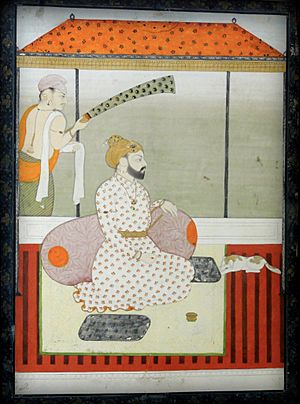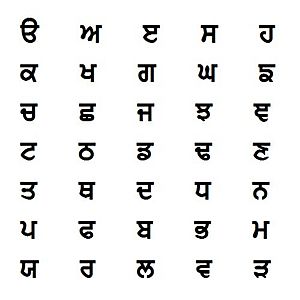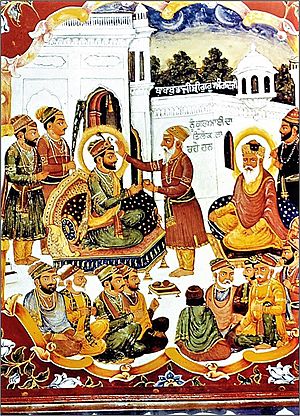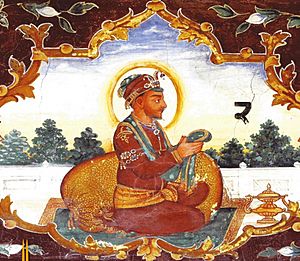Guru Angad facts for kids
Quick facts for kids Guru Angad |
|
|---|---|
| ਗੁਰੂ ਅੰਗਦ | |

Miniature painting depiction of Guru Angad
|
|
| Religion | Sikhism |
| Known for | Standardising the Gurmukhi Script |
| Other names | Second Master Second Nanak |
| Personal | |
| Born | Lehna 31 March 1504 Matte-di-Sarai (Sarainaga), Sri Muktsar Sahib, Panjab |
| Died | 29 March 1552 (aged 47) Khadur Sahib, Tarn Taran district |
| Spouse | Mata Khivi |
| Children | Baba Dasu (1521–1598) Baba Dattu (1524–1575) Bibi Amro (1529–1601) Bibi Anokhi (1531–1608) |
| Parents | Mata Ramo and Baba Pheru Mal |
| Religious career | |
| Based in | Khadur |
| Predecessor | Guru Nanak |
| Successor | Guru Amar Das |
Guru Angad (born Lehna; March 31, 1504 – March 29, 1552) was the second of the ten Sikh gurus. A Guru is a spiritual teacher in Sikhism.
Before becoming a Guru, Lehna met Guru Nanak, who founded Sikhism. Lehna became a Sikh and served Guru Nanak for many years. Guru Nanak was so impressed that he gave Lehna the name Angad, which means "my own limb." He then chose Angad to be the second Sikh Guru.
After Guru Nanak passed away in 1539, Guru Angad took over leading the Sikh community. He is especially remembered for making the Gurmukhi alphabet official. This alphabet is used to write the Punjabi language. He also started collecting the hymns (religious songs) of Guru Nanak. Guru Angad himself wrote 63 of his own hymns. Instead of choosing one of his own sons, he picked his follower Guru Amar Das to be the third Guru of Sikhism.
Contents
Biography
Early life and family
Guru Angad was born as Lehna in a village called Matte-di-Sarai in the Punjab region. His father, Pheru Mal, was a successful trader. His mother's name was Mata Ramo. Like all Sikh Gurus, Lehna belonged to the Khatri caste.
When he was 16, Angad married Mata Khivi in 1520. They had two sons, Dasu and Datu, and two daughters, Amro and Anokhi. His family had to leave their home because of the armies of Babur, a powerful ruler. They then settled in a village called Khadur Sahib, near the Beas River.
Before he became a Sikh, Lehna was a religious teacher in Khadur. He followed the goddess Durga. In his late twenties, Lehna met Guru Nanak. He became Guru Nanak's follower and served him loyally for about six or seven years. During this time, he gave up his old Hindu way of life.
Chosen as the next Guru
There are many stories about why Guru Nanak chose Lehna to be his successor instead of his own sons. One story tells of a jug that fell into the mud. Guru Nanak asked his sons to pick it up, but they refused because it was too dirty. Then he asked Bhai Lehna. Lehna immediately picked the jug out of the mud, cleaned it, and filled it with water for Guru Nanak.
Guru Nanak was very pleased. He touched Lehna and renamed him Angad, meaning "part of my body." On September 7, 1539, Guru Nanak named him his successor and the second Nanak.
After Guru Nanak passed away on September 22, 1539, Guru Angad was very sad. He went into a room in a follower's house and stayed there for a while. Baba Buddha, a respected Sikh, found him and asked him to return and lead the community. Guru Angad then moved from Kartarpur to Khadur Sahib.
At first, not many Sikhs accepted Guru Angad as their leader. Guru Nanak's sons also claimed to be the rightful successors. But Guru Angad focused on teaching Guru Nanak's ideas. He also worked to build the community by organizing charitable activities like Langar.
Meeting the Mughal Emperor
Around 1540, the second Mughal Emperor of India, Humayun, visited Guru Angad. Humayun had just lost his throne to Sher Shah Suri.
According to Sikh stories, when Humayun arrived, Guru Angad was teaching children. Humayun was angry because the Guru did not immediately greet him. Guru Angad reminded Humayun that he should have fought for his throne instead of running away. He told Humayun that he should not try to attack someone who is praying. Sikh texts written later say that Guru Angad blessed the emperor and told him he would regain his throne one day.
Death and successor
Before he passed away, Guru Angad chose Guru Amar Das as his successor. This followed the example set by Guru Nanak. Amar Das was born into a Hindu family and had traveled a lot, even going on pilgrimages to the Himalayas.
Around 1539, Amar Das met a holy man who asked him why he didn't have a spiritual teacher. When he returned home, he heard Bibi Amro, Guru Angad's daughter, singing a hymn by Guru Nanak. Amar Das learned about Guru Angad from her. He then met Guru Angad in 1539 and accepted him as his spiritual teacher, even though Guru Angad was much younger than him.
Amar Das showed great dedication and service to Guru Angad. Sikh tradition says he would wake up early to fetch water for Guru Angad's bath. He also cleaned and cooked for the volunteers and spent a lot of time meditating and praying. Guru Angad named Amar Das as his successor in 1552. Guru Angad passed away on March 29, 1552.
Influence and contributions
Gurmukhi script

Guru Angad is given credit for developing the Gurmukhi script. This script is now the standard way to write the Punjabi language in India. The first Sikh scriptures and most old Sikh writings are in Gurmukhi.
Guru Angad improved and standardized the writing styles used in the region to create Gurmukhi. He also wrote 62 or 63 hymns, which are included in the Guru Granth Sahib. His main importance was in organizing Guru Nanak's hymns. Guru Angad oversaw the writing down of Nanak's hymns, preparing the way for the Sikh holy book. This also helped start Punjabi literature.
Langar and community work
Guru Angad made the Langar system more organized. Langar is a free community kitchen found in all Sikh temples. Visitors can get a simple, free meal together. He also set rules for the volunteers (called sevadars) who worked in the kitchen. He taught them to treat the Langar as a place of rest and safety, and to always be polite and welcoming to everyone.
Guru Angad also visited other places where Guru Nanak had taught Sikhism. He started new centers, which helped make the Sikh community stronger.
Mall Akhara (Wrestling Arenas)
Guru Angad loved wrestling. He started a system of Mall Akharas, which are like wrestling arenas or gyms. In these places, people learned physical exercises, martial arts, and wrestling. He also taught about staying healthy and avoiding things like tobacco.
He believed it was important to keep the body healthy and to exercise every day. He founded many such Mall Akharas in different villages, including some in Khadur. People would usually wrestle after their daily prayers, and they also played games and did light wrestling.
Images for kids
See also
 In Spanish: Gurú Angad Dev Ji para niños
In Spanish: Gurú Angad Dev Ji para niños
- Guru Granth Sahib
- List of places named after Guru Angad Dev










